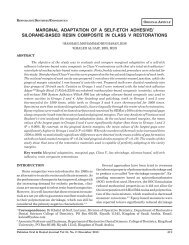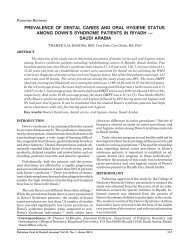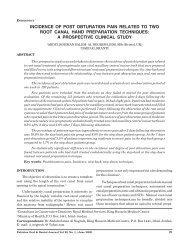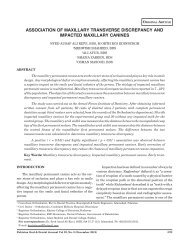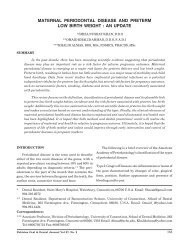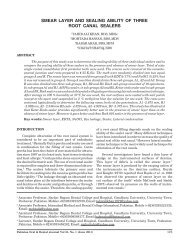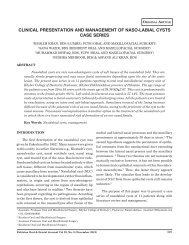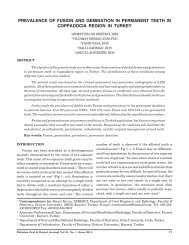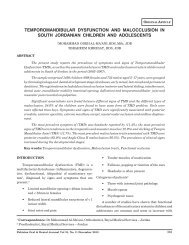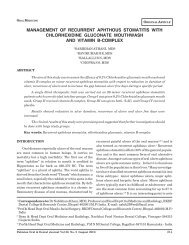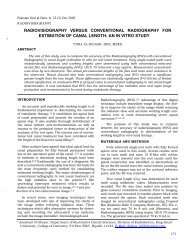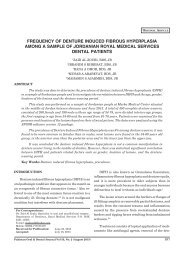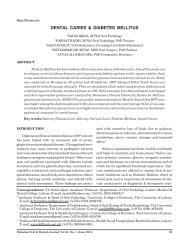31-Podj (35).pmd - Pakistan Oral and Dental Journal - PODJ
31-Podj (35).pmd - Pakistan Oral and Dental Journal - PODJ
31-Podj (35).pmd - Pakistan Oral and Dental Journal - PODJ
Create successful ePaper yourself
Turn your PDF publications into a flip-book with our unique Google optimized e-Paper software.
The role of interpupillary distance in the selection of anterior teeth<br />
ORIGINAL ARTICLE<br />
THE ROLE OF INTERPUPILLARY DISTANCE IN THE SELECTION OF<br />
ANTERIOR TEETH<br />
1<br />
MUHAMMAD WAQAR HUSSAIN, BDS, FCPS Part-II Trainee<br />
2<br />
KHEZRAN QAMAR, BDS, FCPS<br />
3<br />
SAJID NAEEM, BDS, FCPS<br />
ABSTRACT<br />
The objective of the present study was to determine the correlation between the interpupillary<br />
distance <strong>and</strong> combined mesiodistal width of maxillary six-anterior teeth in the study.It was a cross<br />
sectional study<strong>and</strong> was carried out from May 2011 to November 2011.<br />
Sampling: Non-probability purposive sampling.<br />
A total of 159 dentate subjects with Angle’s class I molar <strong>and</strong> canine relationships were selected<br />
from the department of Prosthodontics, Lahore Medical <strong>and</strong> <strong>Dental</strong> College, Lahore. The exclusion<br />
criteria included the subjects with history of orthodontic treatment, extractions, drifting <strong>and</strong> attrition<br />
of the teeth. Subjects having any restoration in upper anterior segment, any facial deformity, crowding<br />
or spacing of anterior teeth were also excluded. The informed consent was taken.<br />
The patients were seated in the upright position <strong>and</strong> were asked to look straight. The interpupillary<br />
distance was measured using the digital caliper. The measurement was made from the mid pupil<br />
of one eye to mid pupil of the other eye.<br />
The intercanine width was measured from the casts of maxillary arches with the help of dental<br />
floss placed at the greatest curvature of the maxillary arch. The distal surfaces of both the maxillary<br />
canines were marked on each sides of the maxillary cast. The dental floss was sectioned at the markings<br />
<strong>and</strong> made straight .The distance was measured between the marks using digital caliper. Both the<br />
parameters were measured three times by the single person to ensure the accuracy <strong>and</strong> the mean was<br />
taken. The measurements were recorded in a predesigned Proforma.<br />
The statistical results of this study showed that there was no correlation between the interpupillary<br />
distance <strong>and</strong> the combined mesiodistal width of maxillary anterior teeth. It was concluded that<br />
the interpupillary distance was not a reliable predictor to select maxillary anterior teeth width for<br />
edentulous patients in the study group.<br />
Key words: Interpupillary distance, anterior teeth selection<br />
INTRODUCTION<br />
The concerns of the completely edentulous patient<br />
include the comfort, function <strong>and</strong> the esthetics. 1 The<br />
function <strong>and</strong> the comfort problems can be resolved<br />
successfully. 2 However restoring the esthetics of a<br />
completely edentulous patient successfully, poses many<br />
challenges. 2 The teeth give each face a unique identity.<br />
When they are lost many individuals undergo some<br />
degree of depression <strong>and</strong> loss of self esteem. 3<br />
1<br />
Postal address: Room #126, Boys hostel, Lahore Medical <strong>and</strong> <strong>Dental</strong> College Tulspura, canal bank north,<br />
Lahore. E-mail: drhussain-@hotmail.com Phone No: 03344091796<br />
2<br />
Assistant Professor, Postal Address: 213 – B, Revenue Employees Cooperative Housing Society, Johar Town,<br />
Lahore, <strong>Pakistan</strong>. Email: drsajidnaeem@hotmail.com Phone No: 042-<strong>35</strong>185858, 0300-4577548<br />
3<br />
Professor, Postal Address: 213 – B, Revenue Employees Cooperative Housing Society, Johar Town, Lahore,<br />
<strong>Pakistan</strong>. E-mail: drsajidnaeem@hotmail.com. Phone No: 042-<strong>35</strong>185858, 0300-42453<strong>31</strong><br />
<strong>Pakistan</strong> <strong>Oral</strong> & <strong>Dental</strong> <strong>Journal</strong> Vol 32, No. 1 (April 2012)<br />
165
The role of interpupillary distance in the selection of anterior teeth<br />
The anterior teeth are primarily related to the<br />
esthetics. 4 They also perform the functions of lip support,<br />
incision <strong>and</strong> phonetics. 4 For a completely edentulous<br />
patient it is important that the size, form <strong>and</strong> the<br />
colour of the teeth must be in harmony with the<br />
surrounding facial environment. 5 All these objectives<br />
are difficult to achieve when preextraction records are<br />
not available.<br />
There is the scientific data in the dental literature<br />
that can be used as a guide for the selection of the size<br />
of the artificial teeth. 6 Some authors have investigated<br />
the relationship between the anthropometric measurement<br />
of the face <strong>and</strong> mesiodistal width of maxillary<br />
anterior teeth. They have suggested a ratio between<br />
the facial size <strong>and</strong> the tooth size that could be used as<br />
a guide in selecting denture teeth. 6, 7, 8 However, the soft<br />
tissue measurements are subjective to change.<br />
The solution to this problem is the use of stable<br />
facial references <strong>and</strong> that are not subjective to<br />
change. One of such l<strong>and</strong>mark is the interpupillary<br />
distance. 9,10 The interpupillary distances is a facial<br />
l<strong>and</strong>mark that is stable <strong>and</strong> does not modify after the<br />
9, 10<br />
age of fourteen.<br />
The aim of the present study was to determine the<br />
correlation between the interpupillary distance <strong>and</strong><br />
the combined mesiodistal width of the maxillary anterior<br />
teeth in study group. If any relation exists then this<br />
may be utilized to select the teeth for those completely<br />
edentulous patients who have no previous records. In<br />
this way the better esthetics results can be obtained for<br />
a complete denture patient.<br />
METHODOLOGY<br />
A total of 159 dentate subjects were selected from<br />
the department of Prosthodontics, Lahore Medical <strong>and</strong><br />
<strong>Dental</strong> College, Lahore. Demographic information like<br />
age <strong>and</strong> sex was recorded. The age ranged from 18 to 30<br />
years. The selection of the subjects was on the clinical<br />
basis. The individuals with Angle’s class I molar <strong>and</strong><br />
canine relationships were included. The exclusion<br />
criteria included the subjects with history of orthodontic<br />
treatment, extractions, drifting <strong>and</strong> attrition of the<br />
teeth. Subjects having any restoration (crowns, bridge,<br />
fillings <strong>and</strong> removable prosthesis) present in upper<br />
anterior segment were also not included in the study.<br />
None of the patient had any facial deformity, crowding<br />
<strong>Pakistan</strong> <strong>Oral</strong> & <strong>Dental</strong> <strong>Journal</strong> Vol 32, No. 1 (April 2012)<br />
or spacing of anterior teeth. The informed consent was<br />
taken from all the subjects for using their data in<br />
research.<br />
For measuring the interpupillary distance participants<br />
were seated comfortably in an upright position<br />
<strong>and</strong> asked to look straight. The measurements were<br />
made from the mid pupil of one eye to mid pupil of other<br />
eye using a digital caliper.<br />
For measurement of inter canine width artificial<br />
stone casts of maxillary arches were made from irreversible<br />
hydrocolloid impressions in perforated stock<br />
trays. <strong>Dental</strong> floss was placed at the greatest curvature<br />
of the maxillary cast <strong>and</strong> made fixed with adhesive<br />
tape; one mark on each side was placed at the distal<br />
surface of the canines. <strong>Dental</strong> floss was sectioned at the<br />
markings, made straight <strong>and</strong> the distance was measured<br />
between the marks using digital caliper.<br />
Each parameter was measured three times <strong>and</strong><br />
average value was computed <strong>and</strong> recorded in a<br />
predesigned Proforma.<br />
The data was entered <strong>and</strong> analyzed in statistical<br />
software (SPSS version 11) a computer based software<br />
program. Quantitative variables interpupillary distance<br />
[IPD] <strong>and</strong> inter canine distance [ICW]) were<br />
presented as mean <strong>and</strong> ± st<strong>and</strong>ard deviation. A qualitative<br />
variable like sex was presented as frequency <strong>and</strong><br />
percentages. Pearson’s correlation coefficient was used<br />
to find out the correlation between interpupillary<br />
distance with intercanine distance. P-value d” 0.05 was<br />
considered for significance.<br />
RESULTS<br />
A total of 159 dentate subjects were included in this<br />
study to ascertain correlation interpupillary distance<br />
<strong>and</strong> combined mesiodistal width of maxillary six-anterior<br />
teeth. Histogram of the age distribution is presented<br />
in figure 1.The average age of the patients was<br />
23.08±2.34 year (95%CI: 22.72 to 23.45). Out of 159<br />
patients 80(50.3%) were male <strong>and</strong> 79(49.7) were female.<br />
The average Inter canine width was 46.01±7.<strong>31</strong><br />
mm (95%CI: 44.96 to 47.25) similarly the average of the<br />
interpupillary distance is presented in table 1. Average<br />
Inter canine width <strong>and</strong> interpupillary distance were<br />
significantly higher in male than in female (p
The role of interpupillary distance in the selection of anterior teeth<br />
TABLE 1: DESCRIPTIVE STATISTICS OF STUDY<br />
CHARACTERISTICS OF THE PATIENTS<br />
n=159<br />
Variables Mean ± 95% Median Max-<br />
SD CI (IQR) Min<br />
Inter canine 46.01± 44.96 to 45.6 61.44-<br />
Width 7.<strong>31</strong> 47.25 (12.3) 26.26<br />
Interpupillary 65.26± 64.41 to 65.5 81.29-<br />
Distance 5.41 66.11 (6.48) 44.41<br />
TABLE 2: COMPARISON OF TOOTH<br />
MEASUREMENT BETWEEN GROUPS<br />
Variables Male Female P-<br />
n=80 n=79 values<br />
Inter canine 47.53±6.72 44.67±7.63 0.013*<br />
Width<br />
Interpupillary 67.57±4.07 62.92±5.62 0.0005*<br />
Distance<br />
Independent sample t test applied<br />
(* significant difference)<br />
Fig 2:<br />
Relationship between Inter Canine Width <strong>and</strong><br />
Interpupillary Width<br />
n=159<br />
Pearson Correlation Coefficient<br />
(r) P-Value Decision<br />
Overall 0.150 0.07 Not significant<br />
Male 0.071 0.53 Not significant<br />
Female 0.056 0.62 Not significant<br />
interpupillary distance established a positive correlation<br />
(r=.15) as presented in figure 2. The relationship<br />
was very weak <strong>and</strong> not significant (P=007). Correlation<br />
was positive <strong>and</strong> not significant for male <strong>and</strong> for female<br />
figure 2.<br />
DISCUSSION<br />
n=159<br />
Mean± SD = 23.08±2.34 Years (95%CI: 22.72 to 23.45)<br />
Median (IQR) = 23(4) Years<br />
Maximum Age = 19 Years<br />
Minimum Age = 29 Years<br />
Fig 1: Histogram of Age Distribution of the patients<br />
The relationship between the Inter canine width<br />
<strong>and</strong> interpupillary distance is presented in scatter plot<br />
which shows week relationship. The pearson correlation<br />
coefficients (r) for the Inter canine width <strong>and</strong><br />
<strong>Pakistan</strong> <strong>Oral</strong> & <strong>Dental</strong> <strong>Journal</strong> Vol 32, No. 1 (April 2012)<br />
Many attempts have been made to quantify the<br />
selection of the anterior teeth for the complete denture,<br />
but no universally accepted method currently<br />
exists for the selection of denture teeth. The methods<br />
based on the soft tissue references show age related<br />
variations. However the hard tissue reference such as<br />
the inter-pupillary distance is a stable <strong>and</strong> reproducible.<br />
The present study was an attempt to investigate<br />
the potential relationship between the combined mesiodistal<br />
width of maxillary anterior teeth <strong>and</strong> the interpupillary<br />
distance.<br />
This study was carried out at the outpatient department<br />
of Lahore Medical <strong>and</strong> <strong>Dental</strong> College, for which<br />
159 subjects were selected r<strong>and</strong>omly. All these subjects<br />
167
The role of interpupillary distance in the selection of anterior teeth<br />
were <strong>Pakistan</strong>i Nationals. The population sample comprised<br />
of 80 (50.3%) male <strong>and</strong> 79 (49.7%) female. The<br />
subjects selected were in the age range of 18 to 30<br />
years. Just similar to the present study Gomes VL et<br />
al 11 conducted their study to find out the relationship of<br />
inter-pupillary <strong>and</strong> inter-canine distance, that could<br />
help in the selection of the denture teeth. They found<br />
out that the interpupillary distance could be used<br />
reliably for the selection of maxillary anterior teeth.<br />
In the present study, the vernier caliper was<br />
used to measure the inter-canine distance on a stone<br />
cast <strong>and</strong> repeated three times by the same operator to<br />
avoid biasness of the results, as used in various studies.<br />
11,12,13, 14,15<br />
The measurement of interpupillary distance was<br />
also recorded by using vernier caliper as done by<br />
Abdullah MA. 16 When measured on the stone cast the<br />
intercanine distance showed a mean value of (46.01 ±<br />
7.<strong>31</strong> mm) to the total sample, <strong>and</strong> it is significantly high<br />
in male than female.<br />
Similarly Al- Wazzan K et al 8 found the intercanine<br />
distance mean value (45.16 ± 3.28 mm) that is nearly<br />
same as in the present study. They also suggested the<br />
difference of the values in gender (45.16 ± 3.52 mm) for<br />
male <strong>and</strong> (43.93 ± 3.22 mm) for female.<br />
The value of the mean of the intercanine distance,<br />
higher than the present study was reported in other<br />
studies. 11, 22, 20 However in the literature there are some<br />
studies available that have shown a low value of the<br />
16, 17 18, 19<br />
mean of the intercanine distance.<br />
Just similar to the present study the gender based<br />
variations were also reported in the literature, 16,8,20<br />
however in contrast to the results of the present<br />
study few studies have reported no gender based<br />
variations. 17,11<br />
The mean interpupillary distance of the subjects in<br />
the present study was (65.26 ± 5.41 mm) for the total<br />
sample, ranging between (81.29mm <strong>and</strong> 44.41 mm).<br />
Cescrio <strong>and</strong> Latta 6 showed a mean value of the (59.16<br />
mm) after measuring 100 subjects of United States<br />
army. Latta, Weaver <strong>and</strong> Conkin 21 found in 109 edentulous<br />
patients a mean of (63.51 mm) <strong>and</strong> a range from(<br />
38.00 to 73.00 mm).<br />
The value of the mean of the interpupillary distance<br />
lower than the present study was reported in<br />
<strong>Pakistan</strong> <strong>Oral</strong> & <strong>Dental</strong> <strong>Journal</strong> Vol 32, No. 1 (April 2012)<br />
some studies. 9, 8, 6 However high value of the mean was<br />
also reported. 11<br />
The variation in the values of the mean in various<br />
studies may be due to the ethnic <strong>and</strong> racial differences.<br />
However the results of some studies are in agreement<br />
with the results of the present study. 20.23<br />
The present sample of 159 subjects also revealed an<br />
increased inter-pupillary distance values for male than<br />
female. These gender based variations similar to the<br />
8, 11, 20<br />
present study were also reported.<br />
There is a weak correlation between intercanine<br />
distance <strong>and</strong> interpupillary distance in the present<br />
study <strong>and</strong> is not significant P=0.007. Correlation was<br />
positive <strong>and</strong> is not significant for female <strong>and</strong> male. The<br />
results of the present study are in agreement with the<br />
results of the study done by Abdullah MA et al. 17 They<br />
also found no relationship between measurement of<br />
interpupillary distance <strong>and</strong> intercanine distance in<br />
their respective study <strong>and</strong> no correlation was found<br />
when population was divided according to the gender.<br />
They have reported a negative <strong>and</strong> an insignificant<br />
correlation value for the interpupillary distance <strong>and</strong><br />
intercanine distance. However in contrast to the present<br />
study Gomes et al 11 concluded that interpupillary distance<br />
could be used reliably in the selection of maxillary<br />
anterior teeth for Prosthodontics. 11 In the study by<br />
al-el-Sheikh HM et al 20 an increased significant correlation<br />
value was noted (r=0.2134 <strong>and</strong> P < 0.001). They<br />
however found correlation between interpupillary distance<br />
<strong>and</strong> intercanine distance in female while no<br />
correlation in male. Gomes VL 11 in contrast found<br />
significantly correlation. They have also reported that<br />
interpupillary distance is a reliable parameter for<br />
the selection of anterior teeth. The variations in<br />
the results of the above mensioned studies showed<br />
the strong ethical correlation between the interpupillary<br />
<strong>and</strong> intercanine distances of the maxillary<br />
arch.<br />
No assessment was made regarding skeletal relationships<br />
<strong>and</strong> ethnic variations. Further studies must<br />
necessarily be carried out to determine if this correlation<br />
leads to different results.<br />
CONCLUSION<br />
From the results of this study, the following conclusions<br />
were drawn;<br />
168
The role of interpupillary distance in the selection of anterior teeth<br />
1 This study showed that the interpupillary distance<br />
is not accurate for the selection of the<br />
artificial teeth in the study group.<br />
2 The measurement of the interpupillary distance<br />
showed the gender-based difference.<br />
REFERENCES<br />
1 Shaikh IA, Qamar K, Naeem S.Relationship of the intercondylar<br />
distance with maxillary intercanine distance.Pak<br />
<strong>Oral</strong> <strong>Dental</strong> J 2011;<strong>31</strong>:470-73.<br />
2 Waliszewski M. Restoring dentate appearance: A literature<br />
review for modern complete denture aesthetics. J Prosthet<br />
Dent April 2005; 93: 386-94.<br />
3 Murrell GA. Aesthetics <strong>and</strong> edentulous patients. J Am Dent<br />
Assoc.1998; 117: 57-63.<br />
4 Akeel R. Attitude of Saudi male patients toward the replacement<br />
of teeth. J Prosthet Dent 2003; 90 (12): 571-77.<br />
5 Petricevic N, Celebic A, Ibrahimagic L, Kovacic I. Appropriate<br />
proportions as guidelines in selection of anterior denture<br />
teeth.Med glas 2008;5(2)103-108.<br />
6 Cesario VA, Latta GH Jr. Relationship between the mesiodisat<br />
width of the maxillary central incisor <strong>and</strong> interpupillary<br />
distance. J Prosthet Dent 1984; 52: 641-43.<br />
7 Smith BJ. The value of the nose width as an esthetic guide in<br />
prosthodontics. J Prosthet Dent 1991; 65: 250-54.<br />
8 Al Wazzan KA. The relationship between intercanthal dimension<br />
<strong>and</strong> the widths of maxillary anterior teeth. J Prosthet<br />
Dent 2001; 86: 608-12.<br />
9 Lucas WP, Pryor HB. Range <strong>and</strong> st<strong>and</strong>ard deviations of certain<br />
physical measurements in healthy children. J Pediatr 19<strong>35</strong>; 6:<br />
533–45.<br />
10 Bindra B, Basker RM, Besford JN. A study of the use of<br />
photographs for denture tooth selection. Int J Prosthodont<br />
2001; 14: 173–77<br />
11 GomesVL,Goncalves LC,Parado CJD, JuniorIL et al. Correlation<br />
between facial measurements <strong>and</strong> the mesiodistal<br />
width of the maxillary anterior teeth. J Esthet Restor Dent<br />
2006;18:196-205.<br />
12 Varjao FM,Nogueira SS.Nasal width as aguide for the selection<br />
of maxillary complete denture anterior teeth in four racial<br />
groups. JProsthodont 2006;15:<strong>35</strong>3-58.<br />
13 Smith BJ. The value of the nose width as an esthetic guide in<br />
Prosthodontic. J Prosthet Dent 1975; 34:562-73<br />
14 Keshvad A, Winstanley RB, Hooshm<strong>and</strong> T. Intercondylar<br />
width as a guide to setting up complete denture teeth. J <strong>Oral</strong><br />
Rehabil 2000; 27:217-26.<br />
15 Ibrahimagic L, Celebic A, Jerolimov et al. Correlation between<br />
the size of maxillary frontal teeth, the width between Alae<br />
Nasi <strong>and</strong> the width between corners of the lips. Acta Stomat<br />
Croat 2001; <strong>35</strong>: 175-79.<br />
16 Abdullah MA. Inner canthal distance <strong>and</strong> geometric progression<br />
as a predictor of maxillary central incisor width. J Prosthet<br />
Dent. 2002; 88: 16-20<br />
17 Abdullah AM, Stipho HD, Tolic YF et al. The significance<br />
of inner canthal distance in prosthodontics. SDJ 1997;9:<br />
36-39.<br />
18 Shillinburg HT, Kaplan MJ, Grace CS. Tooth dimensions.<br />
A comprenhsive study. J South Calif. Dent. Asso 1972;<br />
40-83.<br />
19 Hoffman W,Bomberg TJ,HarchRA.Inter alar width as a<br />
guide in denture tooth selection.J Prostho Dent 1986;55:<br />
219-21.<br />
20 al-el-Sheikh HM, al-Athel MS. The relationship of interalar<br />
width, interpupillary width <strong>and</strong> maxillary anterior teeth width<br />
in Saudi population. Odonto-stomatol Trop. 1998 Dec; 21(84):<br />
7-10.<br />
21 Latta GH, Weaver JR, Conkin LE. The relationship between<br />
the width of the mouth, interalar width, bizygomatic width <strong>and</strong><br />
interpupillary distance in edentulous patients. J Prosthet<br />
Dent 1991; 65: 250-4.<br />
<strong>Pakistan</strong> <strong>Oral</strong> & <strong>Dental</strong> <strong>Journal</strong> Vol 32, No. 1 (April 2012)<br />
169



